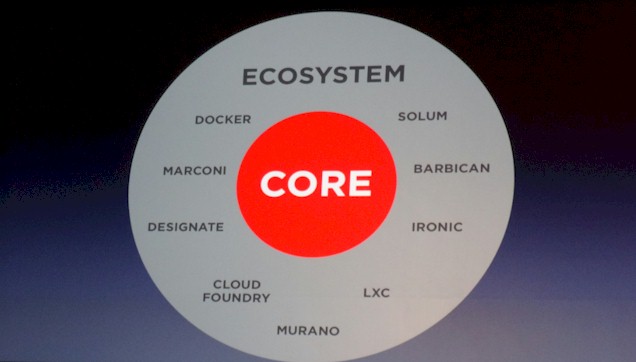OpenStack Cloud Rebels To Mimic Linux Strategy

OpenStack is up against some pretty big odds, taking on the likes of Amazon Web Services, Google, and Microsoft to determine the future of cloud computing. And it thinks of itself as the Rebel Alliance up against the Death Star. Or at least one prominent OpenStacker speaking at the OpenStack Summit in Atlanta does.
Google and Microsoft have deep pockets and Amazon seems to care less about making money (by which we mean profits) than it does about transforming whole sectors of the economy (and it is hard not to respect that). But OpenStack, as a collective boasting more than 16,000 members, is not without its own strengths, and the top brass in the foundation that controls it were on hand at the OpenStack Summit in Atlanta to try to rally the troops in their battle for the future of clouds.
Over 4,600 people showed up for OpenStack Summit, which is a mix of training and education as well as the place where the features of next release of the cloud controller, code-named “Juno,” will be hammered out by developers and users. With the maturity of OpenStack, this was one of the themes of the opening presentations. Jonathan Bryce, executive director of the OpenStack Foundation and a former executive at Rackspace Hosting, which four years ago started the OpenStack project along with NASA, said that the community was making a concerted effort to expand from engaging with developers to include operators who work with OpenStack running clouds all day as well as the higher-ups in their organizations who make the decisions (which he called users). The week-long shindig in Atlanta has attracted more than 600 OpenStack operators and will have two days of discussions between operators and developers as they work together to forge the future of OpenStack. (That should be an interesting meeting.) Bryce also put out a call to get more people to do code reviews to speed up and improve the approval process for OpenStack code.
What the OpenStack community wants is to move faster. Time and again during the keynotes this theme kept coming up, that OpenStack is all about turning up the agility and speed of infrastructure so it can match the agility and speed of modern programing tools and methods.
“If you think about what all of this enables, and where we are heading, we are really living in a software-defined economy,” explained Bryce. “It touches every business, every industry. And in the software-defined economy, every company competes with a startup. The barrier to entry in every industry is dramatically lower. And what this means is that if you are a very large company, that is not necessarily a benefit to you, it is not necessarily a competitive advantage. In fact, that can be a disadvantage. If you are in the banking industry, you are having to compete with all kinds of technology companies now. Big media has to compete with all kinds of startups and technology companies. Netflix just won an Emmy, and this is not just about delivering on-demand video; they are producing award winning content. In the automotive industry you have Tesla, and Elon Musk is an amazing innovator and he is not happy with just taking on the automotive industry, he is now taking on the Air Force. Even the Air Force has to compete with startups.”
The expense of software development over the years is what has kept innovation low and with more automation to make the underlying infrastructure more malleable, more agile programing methods can be deployed, while at the same time allowing developers to experiment more, to try things quickly, and let them fail fast, as Facebook puts it.
“What we are talking about is increasing the velocity of money, and software is key to that,” Bryce added.
This sentiment was echoed by Glenn Ferguson, head of private cloud deployment at Wells Fargo Bank, who spoke with Bryce during the keynote. Ferguson goes way back in IT automation, having worked out Loudcloud, the cloud hosting startup from Marc Andreessen that eventually morphed into Opsware (now part of Hewlett-Packard), and was director of cloud engineering at Netflix as well as an executive in HP’s Cloud Services organization as it adopted OpenStack.
“Your infrastructure has to keep speed with software,” said Ferguson. “Without that, then the software does no good.” Every company wants to have cloudy infrastructure that looked like Amazon Web Services, but big banks need to deal with regulations and compliance. As he explained it, you manage the line – the API level – with developers above that line and operators below that line along with all of the features to do reporting and auditing to meet compliance regulations.
The other thing that is important for Wells Fargo is that vendors now know that it has chosen OpenStack as its cloud standard, and while it will not be precise about precisely where and how it is using OpenStack, those vendors who want to sell hardware and software now know that they need to support OpenStack. And the community gets to use Wells Fargo as a reference. “We are trying to run a serious business on this technology,” Ferguson concluded. “We have competitors. We are a large bank, we have a target on our back, and technology is certainly something we need to do to remain competitive.”
At media giant Walt Disney, speed was the focus as well. Chris Launey, director of cloud services and architecture, spoke with Bryce about its implementation of OpenStack, which went from a pilot program with OpenStack distributor MetaCloud to a production environment in four months.
Bryce flashed up the triangle of choices that we are all familiar with, which has fast, cheap, and good on its vertices and you only get to pick two. Launey changed all the vertices to fast.
“It is funny. If you look at what any business needs these days, when you are doing it all with information, what you need is speed,” said Launey. “It is what everybody craves. If you give somebody enough fast, they can make their own cheap. They can get their product to market quickly, and respond to market demands and changes, they can be the first candy game on Facebook instead of the second. You can create your own cheap by getting to market more quickly and increasing your revenues. You can create your own fast by increasing your development cycles. You can change things all the time and only change little bits at a time, using continuous delivery and continuous integration models and the software quality goes up. So if you give somebody a faster lover’s pizza with an extra helping of fast, they will make their own cheap and good.”
Again, of course, Disney did not detail precisely what it is doing with OpenStack, but it does admit to using it. Every corporate logo makes it more like that another Global 2000 company will give OpenStack a whirl, and if the momentum continues, then it won’t be long before OpenStack is the safe bet in the enterprise when it comes to managing both physical and virtual infrastructure.
But OpenStack certainly has its enemies and just like Linux, it is going to have to earn its place in the datacenter. Linux took off in supercomputing first, becoming the lingua franca for clustered systems that replaced other types of federated and massively parallel machines. Soon thereafter, it displaced Solaris as the default platform for Internet-style distributed systems, and these days, all of the large public clouds but Microsoft’s Azure are based on Linux at their heart.
“We have a lot to celebrate as a rebel alliance,” said Troy Toman, who is cloud architect at Rackspace and who oversees all of its open source efforts, “We have more members, we have more active contributors, we still need more reviewers and we have got a lot more capability and most importantly we have got more users. It is amazing progress for four years. But unfortunately we are really at the first stages of this journey, because as Han Solo once said, that is no moon. We may not be facing the Death Star, but we are far from being able to declare victory in what we are trying to do here. We have really just won the right to compete and we know that some large proprietary cloud vendors have earned that right, too. They are pushing their version of the future, and it doesn’t include open source.”
Toman said that the top three proprietary cloud vendors – he did not name them, but they are AWS, Google, and Microsoft – have committed $25 billion in investments for their clouds in 2014 alone. “They also have thousands of developers, and we may have our thousands, but they are bringing them, too. And they don’t worry about trying to achieve consensus and they execute relentlessly.”
To help take on these proprietary cloud providers, OpenStack is cooking up a core definition of OpenStack, which it calls Defcore, that all OpenStack-branded distributions will presumably want to adhere to. Toman said that this core code would be comprised of the parts of OpenStack that have pervasive usage, that play well with other components, that align with the technical direction outlined by OpenStack project leaders, that are well documented and understood, and that take a system view.
Toman admitted that a few years back, he was of the opinion that OpenStack just needed to be an infrastructure cloud, but now, he has come to the realization that there needs to be a core that is wrapped by a rich ecosystem, much as Linux was wrapped by Apache, MySQL, and PHP but remained separate from it. Just as is the case with Linux, features will have to earn the right to be included in the core, and in many cases there will be various options in the ecosystem – Solum, OpenShift, and Cloud Foundry for platform services – just like Linux has myriad databases and file systems.
Toman said that the OpenStack community had been working on the testing regimen and definitions of this core for the past eighteen months and that he hoped that the work could be finished by the end of 2014.












